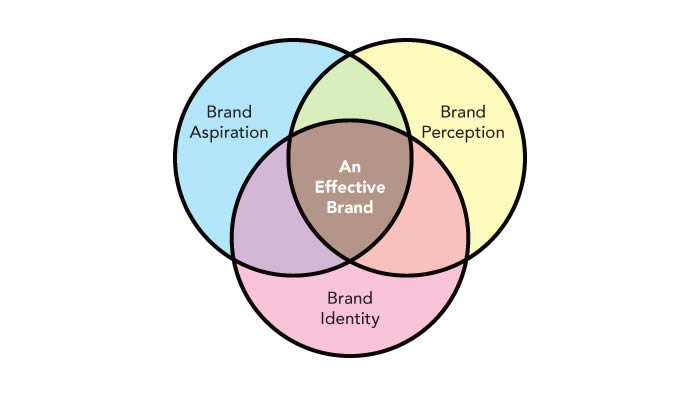Up front, everything—even if never touched by a designer—has a brand. Even people or products you hate have a brand. The brand is recognized by the thing or person that is out there, not by a logo. So, a brand can exist even without someone intending it to exist, but it’s there and the public defines the brand.
We can think of an effective brand as the conjoining of three spheres: (1) what a person intends to the brand to be (Goals/Aspiration); (2) what the public perceives the brand to be (Perception); and (3) what the brand actually is (Identity).

Some things have less effective brand recognition as the spheres overlap in a lopsided way, but great brand recognition is the equal overlapping of the spheres.
Here the designer, art director or Creative Director might say ”well, what’s wrong with having a bigger perception than the actual identity or goals?” The hope here is that with the right design we can make the product better in the public eye. The thing is, while that is financially great in the short-term, in the long term the brand’s perception could be quickly exposed and collapse in on itself. Think of the housing market bubble and the bank crisis and you’ll get an idea of what I’m saying—the same thing can happen with a product or person.

What we Creative Directors have to do then is figure out ways to back up the brand that functions beyond the Marketing Director’s focus group briefs.
Brands have all sorts of things that pull against each other and the traditional avenues of input are the advertisements and the final product. We measure those things but by then countless dollars have been invested and the brand is already in play.
Admittedly, in some cases it might mean shifting the aspirational intents to focus on the aspiration itself. Look at Apple, who has HUGE Brand Perception; they don’t ultimately focus on their product. They turn your eyes to the fact that this is an Apple Product. The market never needed an iPad, but it understands the Apple Brand and now it wants the iPad.
Creative Directors have to increase their exposure to cultures outside of their design sphere. I don’t mean marketing goals but rather how to use a creative piece to tap into actual market research.
New media affords us a way to interact with the actual market research before our own brand launches. With social media we can get conversations going about what people like and what they’re looking for. J.J. Abrams is known for plot twists so we saw absolutely no marketing for Cloverfield except for the fact that there was a block on marketing. The buzz was created simply by underscoring that there will be no buzz. What about viral marketing that is launched without the actual product in play? Or what about strategic patent filings? How much buzz is created by Apple filing a patent for a 7 inch bevel-edged rectangle with a circle on it?
We have to be careful here: I’m not saying that we lie with our filings or viral video. I’m saying we figure out ways to get conversations going and use all that information to bolster the brand.

What do you think: is there a way here to re-think how we Creative Directors think about our field? Should we be pre-influencing our brand or do you think there is an ethical line here that is being crossed?




